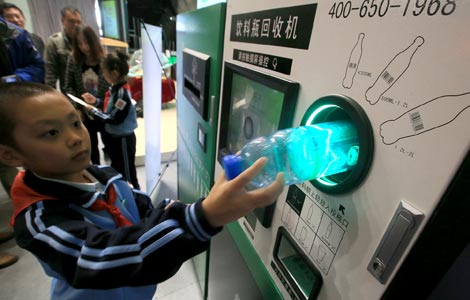Natural gas-use increase raises concern
Updated: 2013-11-17 07:03
By Zheng Xin (China Daily)
|
||||||||
Experts are voicing worries over plans to reduce coal combustion by using more natural gas as the heating season approaches.
The large number of coal power plants being refitted as gas power plants will increase nitric oxide emissions, Chinese Academy of Engineering academician Ni Weidou said.
"Natural gas should be used rationally, and coal-to-gas projects should be implemented cautiously," Ni said.
"Otherwise, more nitric dioxide will be discharged and pollute the air."
Ni made the remark at an international forum on air quality management in Beijing organized by the Energy Foundation on Saturday.
Coal's proportion of the energy mix should not exceed 65 percent by 2017, when clean coal should account for at least 70 percent of total coal use. The clean coal proportion is around 80 to 90 percent in most developed countries.
The country will by then also have added more than 150 million cubic meters worth of natural gas pipeline-transportation capacity.
Ni said advanced technology enables clean coal to produce very low emissions. Nitric dioxide emissions are lower from all grades of coal compared with natural gas, he said.
"Considering more fuel is combusted in gas-fired combined heat and power boilers in order to get the same amount of heat, the nitric oxide emission is larger than that from coal-fired ones," he said.
Ni said the total emission of nitric dioxide will increase and the air quality will worsen if the four coal power plants in downtown Beijing are transformed into gas-fired CHP while contributing the same amount of heat.
Feng Yongfeng, founder of the Beijing-based environmental NGO Green Beagle, is also concerned about the burden placed on other cities to ensure Beijing's gas supply.
"The use of clean energy might burden neighboring provinces and regions, and the government should not be unrealistically optimistic about the project," Feng said.
Also, upgrading coal power plants into natural gas plants is expensive, and there has not yet been a detailed disclosure of the nationwide cost.
"The government should think about the input-output ratio and see if the solution works best under the current circumstances to decide whether natural gas or clean coal is better," Feng said.
The capital's coal combustion-reduction plan, which aims to replace coal with natural gas in all downtown areas, has received 1.3 billion yuan ($213 million) in investment. It is expected to cut coal consumption by 600,000 tons a year, sulfur dioxide by 1,680 tons, and smoke and dust by 1,392 tons, the Beijing Environmental Protection Bureau has reported.
Municipal government figures show coal accounts for 16.7 percent of PM2.5, which is too small for the respiratory system to filter.
Another challenge is the shortage of natural gas.
"The coal-to-gas conversion project currently carried out in many northern cities could cause serious natural gas supply shortages," Ni said.
"The target of coal-to-gas should be focused on maximum emission reduction."
Ni worried this winter will witness a worse imbalance between supply and demand of natural gas in China compared with recent years.
China's natural gas shortage is about 8 billion cu m. Natural gas accounts for more than 30 percent of developed countries' energy mixes but only 5 percent of China's.
Beijing environmental protection bureau deputy director Liu Wei told China Daily in a previous interview that the capital has enough natural gas for this winter because of transfers from the Inner Mongolia autonomous region, the Xinjiang Uygur autonomous region, and Shaanxi and Hebei provinces.
But while experts highlighted potential problems with increasing natural gas use, they also pointed to its boons.
"Replacing some small industrial boilers with CHP models will improve evident pollutant emission reduction," China Academy of Engineering academician Hao Jiming said.
If the new 150 million cu m of natural gas supply replaced some coal-burning industrial boilers, it is expected that would reduce sulfur dioxide by more than 3.59 million tons and smoke by more than 1.34 million tons, he said.
zhengxin@chinadaily.com.cn.
(China Daily 11/17/2013 page2)

 Chinese, US militaries practice disaster relief
Chinese, US militaries practice disaster relief
 3D light show displayed in Shanghai
3D light show displayed in Shanghai
 Nation's FDI in US getting more diverse
Nation's FDI in US getting more diverse
 Hit litterbugs with fines, not insults
Hit litterbugs with fines, not insults
 Wu Lei goal keeps alive China's hope in Asian Cup
Wu Lei goal keeps alive China's hope in Asian Cup
 US carrier starts Philippine storm relief
US carrier starts Philippine storm relief
 Treasures under the hammer
Treasures under the hammer
 'Reverse' vending machine sells idea of recycling
'Reverse' vending machine sells idea of recycling
Most Viewed
Editor's Picks

|

|

|

|

|

|
Today's Top News
1 killed, 3 wounded at house party shooting in Houston
Obama: US poised to control own energy future
China ready to send rescue teams to Philippines
Chinese, US militaries practice disaster relief
Wait a minute, baby
Map unveiled for profound reform
Typhoon death toll tops 3,621
House OKs health care plans
US Weekly

|

|







